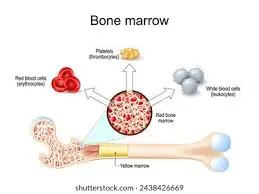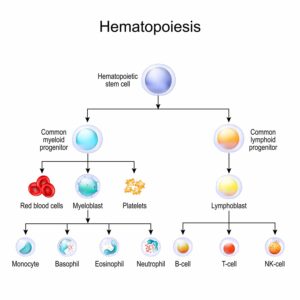
Hematopoiesis
Hematopoiesis ek complex aur lifelong process hai jisme blood cells ka formation hota hai — RBCs (erythrocytes), WBCs (leukocytes) aur platelets (thrombocytes) — jo sab hematopoietic stem cells (HSCs) se bante hain.
Iska main kaam hai:
-
Oxygen transport maintain karna (via RBCs),
-
Infection ke khilaf defense (via WBCs),
-
Aur bleeding ko rokna (via platelets).
Ye process continuously active rehta hai aur body ke needs ke hisaab se adjust hota hai (jaise infection, bleeding ya hypoxia ke time).
Physiological Aspects of Hematopoiesis
Sites of Hematopoiesis (Zindagi ke alag stages mein)
Embryo mein:
-
Mesoblastic phase (2–8 weeks): Yolk sac mein start hota hai; yahan primitive RBCs bante hain (nucleated).
-
Hepatic phase (6 weeks–birth): Liver main site ban jata hai; spleen aur thymus bhi help karte hain.
-
Myeloid phase (5 months onwards): Bone marrow main site ban jata hai aur sab mature blood cells yahi bante hain.
Birth ke baad:
-
Sabhi bones mein red marrow hota hai initially.
-
Age badhne par hematopoiesis sirf axial skeleton (sternum, pelvis, ribs, vertebrae) mein hota hai.
-
Red marrow → yellow marrow (fatty) mein convert hota hai, lekin stress condition mein red marrow wapas activate ho sakta hai.
Hematopoietic Stem Cells (HSCs)
-
HSCs self-renew karte hain aur sabhi blood cell types mein differentiate kar sakte hain.
-
Markers: CD34+, CD38−, Lin−.
-
HSCs se:
-
Myeloid progenitor → RBCs, platelets, neutrophils, monocytes.
-
Lymphoid progenitor → B cells, T cells, NK cells.
-
Hematopoiesis ki Regulation
Ye process tightly regulated hota hai via growth factors, cytokines, aur bone marrow microenvironment.
A. Important Growth Factors
| Growth Factor | Kahan se banta hai | Kya kaam karta hai |
|---|---|---|
| Erythropoietin (EPO) | Kidney | RBCs ka production badhata hai |
| Thrombopoietin (TPO) | Liver, kidney | Platelet formation mein help karta hai |
| G-CSF | Endothelial cells, macrophages | Neutrophil production |
| GM-CSF | Macrophages, T cells | Myeloid cells ka stimulation |
| IL-3, IL-6, SCF | Multiple sources | Multipotent cells ka survival aur proliferation |
B. Feedback Mechanisms
-
Hypoxia → EPO ↑ → RBCs ↑
-
Infection → IL-6 ↑ → Neutrophils ↑
-
Bleeding → TPO ↑ → Platelets ↑
C. Bone Marrow Niche
-
Yahan stromal cells, ECM proteins (fibronectin, collagen) aur adhesion molecules (VCAM, ICAM) present hote hain.
-
Endosteal region mein low O₂ tension hota hai jo HSCs ko quiescent rakhta hai.
Morphological Aspects
Different Cell Lineages
A. Erythropoiesis
-
Proerythroblast → Basophilic erythroblast → Polychromatic → Orthochromatic → Reticulocyte → RBC.
-
Nucleus gradually chhota hota hai aur cytoplasm pink (hemoglobin) ho jata hai.
B. Granulopoiesis
-
Myeloblast → Promyelocyte → Myelocyte → Metamyelocyte → Band → Neutrophil/Eosinophil/Basophil.
-
Nuclear changes aur specific granules ka appearance hota hai.
C. Monocytopoiesis
-
Monoblast → Promonocyte → Monocyte → Tissue macrophage.
D. Lymphopoiesis
-
B cells bone marrow mein mature hote hain.
-
T cells thymus mein jaake mature hote hain.
-
NK cells cytotoxic activity ke liye ready hote hain.
E. Thrombopoiesis
-
Megakaryoblast → Promegakaryocyte → Megakaryocyte → Platelet formation via cytoplasmic fragmentation.
Bone Marrow Structure
-
Red marrow: Active cell formation.
-
Yellow marrow: Mostly fat.
-
Sinusoids: Channels jahan se mature cells circulation mein jaate hain.
-
Reticulin fibers: Structural support dete hain.
Biochemical Aspects
Hemoglobin Synthesis
A. Heme Synthesis
-
Succinyl-CoA + Glycine → δ-ALA (mitochondria)
-
Series of steps → Protoporphyrin IX → Heme (Ferrochelatase se Fe²⁺ add hota hai)
Lead poisoning ALA dehydratase aur ferrochelatase ko inhibit karta hai → anemia hota hai.
B. Globin Chain Synthesis
-
Cytoplasm mein hoti hai.
-
Alpha aur Beta chains ka proper synthesis zaroori hai (thalassemia mein defect hota hai).
Metabolic Pathways
Erythrocytes:
-
Mitochondria nahi hote.
-
Anaerobic glycolysis se ATP milta hai.
-
Pentose phosphate pathway NADPH provide karta hai (oxidative stress se bachaata hai).
Neutrophils:
-
High glycolytic rate.
-
NADPH oxidase system ROS (superoxide) banata hai → microbes ko kill karta hai.
Micronutrients & Vitamins
| Nutrient | Role | Deficiency Consequence |
|---|---|---|
| Iron | Heme synthesis | Microcytic anemia |
| B12 & Folate | DNA synthesis | Megaloblastic anemia |
| Vitamin C | Iron absorption | Anemia |
| Copper | Iron metabolism | Hypochromic anemia |
| Zinc | DNA synthesis | Immunity low, anemia |
Transcription Factors
-
GATA-1: RBCs aur megakaryocytes ke liye.
-
PU.1: Myeloid lineage.
-
NOTCH1: T cell commitment.
-
IKAROS: Lymphoid lineage development.
Ye factors chromatin aur gene expression ko regulate karte hain.
Apoptosis aur Cell Cycle Control
-
Balance maintain karne ke liye faulty ya extra cells remove hote hain.
-
p53, Bcl-2 family aur cyclin-CDK complexes cell cycle ko regulate karte hain.
Clinical Correlates
-
Aplastic anemia: Bone marrow failure.
-
Leukemia: Immature cells ka uncontrolled growth.
-
MDS (Myelodysplastic Syndrome): Dysplasia with ineffective hematopoiesis.
-
Bone Marrow Transplant: Cure ke liye use hota hai in severe cases.
Recent Advances
-
Single-cell RNA-seq: Individual cells ka profile banata hai.
-
Gene Therapy: Thalassemia aur sickle cell ke liye promising hai.
-
iPSC-derived blood cells: Regenerative medicine ka future.
-
Artificial bone marrow scaffolds: Lab mein marrow-like environment create karna.